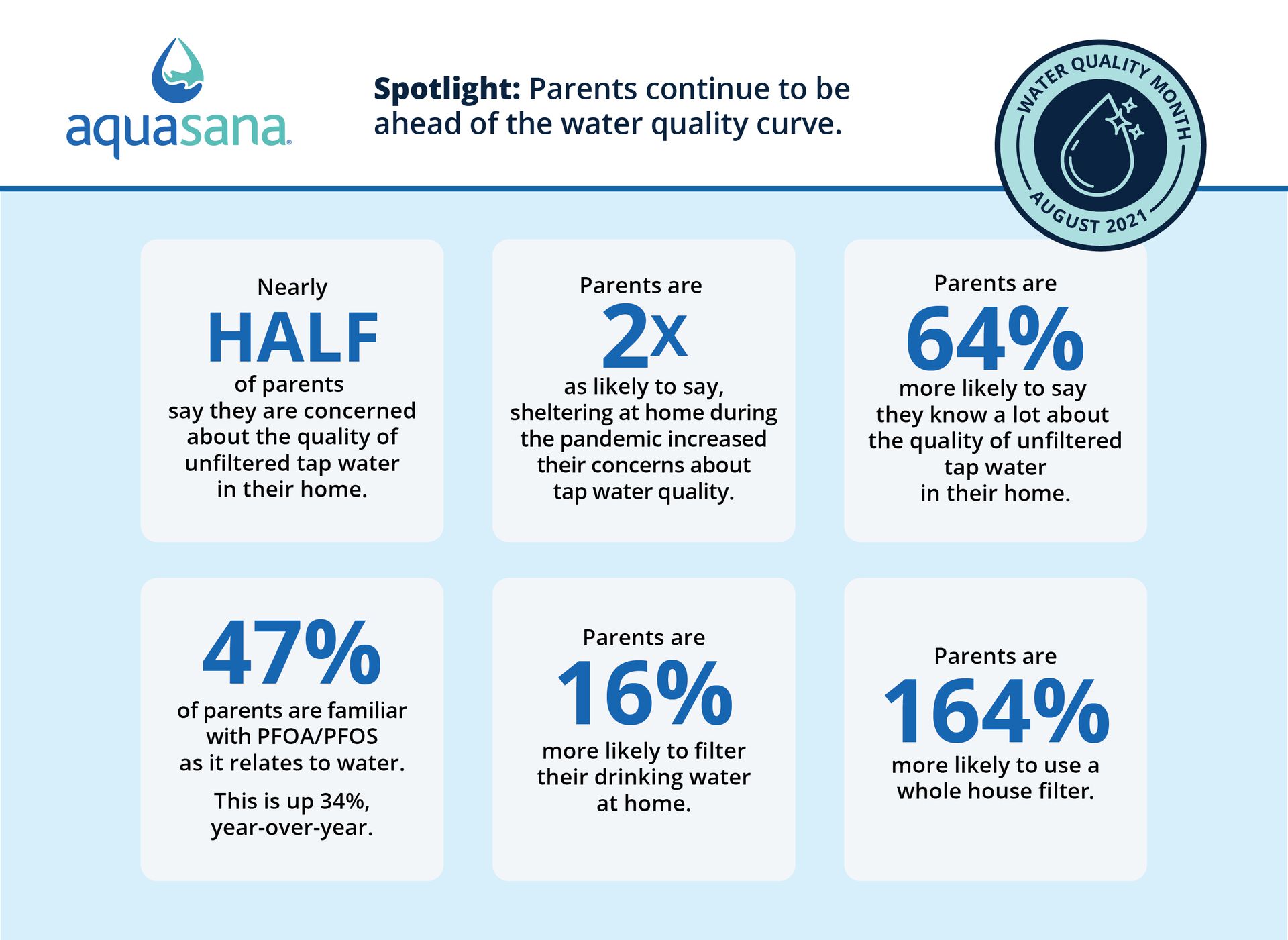Bottled water is also worse for the environment, with Americans consuming 73 billion half-liter bottles of water a year. That’s enough to circle the globe with plastic more than 370 times! The EWG also notes that only 30% of plastic bottles are recycled while the remaining bottles end up in landfills, beaches, and oceans.
Instead of buying wasteful plastic bottles of water, consider investing in a reusable water bottle and filling it up with clean and healthy, filtered water at home. If you’ll be filling up throughout the day, opt for a reusable bottle with a built-in filter. For kids heading back to school this fall, Aquasana’s award-winning Clean Water Bottle removes up to 99% of lead, chlorine, and bacteria for added peace of mind.
Parents Take More Water Quality Action Than Non-Parents
In correlation with their higher levels of knowledge and concern about water quality, it seems parents are also taking proactive steps to protect their homes and families. According to the survey, parents are not only more likely to filter their drinking water (16%), but they’re also more likely to use higher-end water filtration products than non-parents.
When it comes to the different types of water filters they’re choosing, we found parents are more likely to use higher-end options. They are:
- 164% more likely to use a whole house filter than non-parents (29% vs 11%)
- 75% more likely to use a shower filter (7% vs 4%)
- 71% more likely to use a water bottle with a filter (12% vs 7%)
- 69% more likely to use an under sink filter (22% vs 13%)
- 60% more likely to use a countertop filter (24% vs 15%)
- 22% more likely to use a refrigerator with a built-in filter (38% vs 31%).
Across the board, parents use water filters on average about 60%-70% more than non-parents. However, that trend varies greatly when it comes to in-line refrigerator filters and whole house filtration systems, in particular. Much less in comparison, parents are only 22% more likely to use a refrigerator with a filter. This may be due to the fact that in-line water filters are generally less effective at reducing harmful contaminants than other point-of-use water filtration systems, especially considering parents’ increased awareness and knowledge on the issue.
On the other end of the spectrum, parents are 164% more likely to use whole house water filters. Unlike point-of-use filters, whole house systems filter water from every tap — including for drinking, brushing teeth, bathing, and laundry — and improve indoor air quality, as well.
In summary, filtering your water is one of the most effective ways to instantly improve the overall health and wellness of a home. Whether you’re a parent or not, Aquasana offers a wide selection of award-winning, high-performance water filtration systems with options that remove up to 99% of 88 contaminants, including fluoride, lead, PFOA/PFOS, pharmaceuticals, pesticides, chlorine and chloramines, and more. From whole house systems to under sink, countertop, and shower filters — we’ve got a solution that will meet your home and family’s unique needs.

Survey Methodology and Definitions
The findings presented in this article are the result of a March 2021 study of 2,143 U.S. adults, ages 18-79, conducted by Aquasana. (Confidence Level: 95%, Margin of Error: 2%)
Survey definitions
Age Cohorts (based on Pew Research)
- Baby Boomers: 1946-64
- Gen X: 1965-80
- Millennials: 1981-96
- Gen Z: 1997-2012
Regions (based on U.S. Census map)
- Northeast: Maine, Massachusetts, New Hampshire, New Jersey, New York, Pennsylvania, Rhode Island, Vermont, Connecticut
- Midwest: Illinois, Indiana, Iowa, Kansas, Michigan, Minnesota, Missouri, Nebraska, North Dakota, Ohio, South Dakota, Wisconsin
- South: Alabama, Georgia, Kentucky, Louisiana, Maryland, Mississippi, North Carolina, Oklahoma, South Carolina, Arkansas, Tennessee, Texas, Virginia, West Virginia, Delaware, Florida
- West: Idaho, Alaska, Montana, Nevada, Arizona, New Mexico, Oregon, Utah, Washington, Wyoming, California, Colorado, Haw
Urban, Suburban, and Rural Classifications
- The urban, suburban, and rural classifications we use are based on the database and definitions from Great Data, which developed their logic using U.S. Census data.
.jpg)